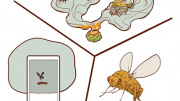Formula One (F1) is a sport where millions upon millions of dollars are spent to go a tenth of a second faster. The rub is that for all the money spent, the advantage is normally short lived, with the advancement either banned by the Fédération Internationale de l’Automobile (FIA), the international motorsports governing body, or adopted by the other teams.
What follows is my personal list of the four most effective and short-lived technological advantages ever to grace an F1 car.
Wings
A modern F1 car is adorned with a glut of aerodynamic devices, all designed to push the car into the ground, effectively increasing the car’s grip and enhancing its ability to go around corners. There was a time though when F1 cars were little more than cigar shaped tubes with wheels sticking out.
These “pre-aerodynamics” cars used mechanical grip — generated through the tires and suspension system — exclusively.
Introduced by Colin Chapman’s Team Lotus part way through the 1968 season on the revolutionary Lotus 49B, the design was quickly adopted by the other teams, and F1 would never again be without the downforce-generating wing.
While it would be inaccurate to say that the wing won Lotus the 1968 championship (that honour arguably belongs to the Ford-Cosworth engine Chapman had the foresight to make a stressed member of the chassis), the Lotus 49B represents a singularity in F1. It marks the divide between the pre-aerodymanic era of the sport, and F1’s modern age.
Movable ground effects
While revolutionary, wings on F1 cars are an imperfect solution, since they come at a high price: drag.
By thrusting something into the airflow you make it harder for the car to move through the air and therefore limit the top speed and its ability to accelerate. The tradeoff in braking and cornering speeds, though, made this an acceptable bargain. That didn’t mean though that teams were content to accept it.
Lotus’ Chapman figured out in the ’70s that if you could sculpt the airflow under an F1 car it was possible to create a vacuum effect, sucking the car to the ground. This gave all the benefit of a wing with none of the drag.
The problem was that in order to maintain this effect the bottom car had to remain at a fixed distance from the road, as any change in this distance would change the amount of suction and destabilize the car.
Alastair Caldwell, an F1 designer in the ’70s, claims that he figured out in ’76 that if you fitted the car with movable skirts on the side of the car, they would prevent air from escaping, and you could minimize the destabilization and increase the overall effectiveness of the ground effects.
In ’78 Chapman used this principal on his Lotus 78, a car that dominated the sport primarily due to its aerodynamics.
Fan car
In response to the gains seen by other teams with movable ground effects, Gordon Murray — one of the most forward thinking automotive designers in the world — designed a car on which a fan actually sucked air from under the car. Known officially as the Brabham BT46B, and unofficially as the “fan car,” Murray skirted the rules forbidding such devices by claiming that the fan was primarily for engine cooling and any aerodynamic advantage was purely coincidental.
In its first — and only — race it won by a margin of almost 35 seconds and reportedly had Chapman furiously designing his own fan-car on the plane home.
The fan car had caused quite a stir among the teams and in response Brabham team owner, Bernie Ecclestone, decided to abandon it when faced with the possibility of creating a conflict between the teams and the rule-makers.
In the early ’80s the FIA banned ground effects by mandating that cars had to have flat underbodies, blaming the increased cornering ability for a series of dangerous crashes, most notably the death of Canadian driver, Gilles Villeneuve.
The “F-duct”
With ground effects banned teams were forced to focus on the aerodynamic advantage provided by wings, despite the drag they caused.
Ideally a car would have wings that could be moved, increasing their angle of attack to provide more downforce in corners, decreasing the angle of attack on the straight, reducing drag while increasing top speed. However, until recently, the FIA has banned movable aerodynamics.
To get around this problem McLaren designed the RW80, more commonly known as the “F-duct.”
Introduced on their 2010 car, the F-duct channels air from the front of the car through the cockpit and to the rear bodywork (see above image). A hole in the duct’s tube normally lets the air exit into the cockpit, however on straights the driver can plug the hole with his knee (this intentionally awkward maneuver allows McLaren to claim that the driver is triggering the system by accident, circumventing the ban on movable aerodynamics), which pressurizes the system and diverts the air rearward, and under the rear wing.
Because the downforce created by the differential of air going over the top of the wing versus the bottom, by channeling air under the wing the F-duct reduces downforce and drag, giving the McLaren a five kilometer per hour advantage on the straight.
Following its introduction, several other teams began developing their own versions of the system, and in a matter of weeks had their own F-ducts, canceling McLaren’s advantage.
Conclusion
With the FIA considering bringing back movable aerodynamics, to help cars pass one another on straights, what little advantage the F-duct provided will effectively be wiped out. This doesn’t mean that teams will give up though. The plans for the next questionably legal device is no doubt sitting on an engineer’s terminal right now, being analyzed by computers, and waiting for the start of the 2011 season.


